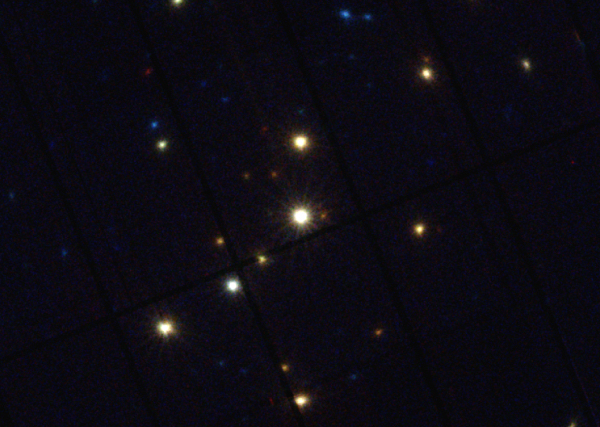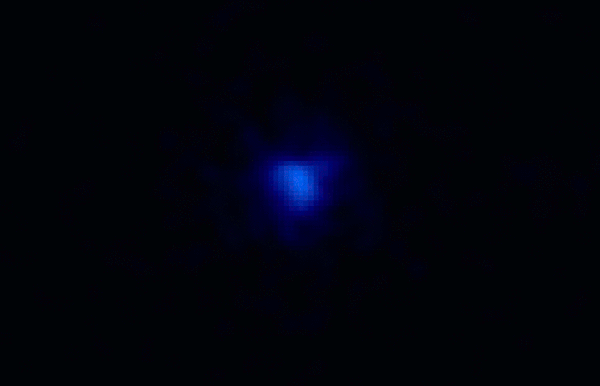XMM-Newton spies first clear X-ray flares from massive stellar lighthouse
26 February 2018
In 2014, ESA's XMM-Newton spotted X-rays emanating from the massive star Rho Ophiuchi A and, last year, found these to ebb and flow periodically in the form of intense flares – both unexpected results. The team has now used ESO's Very Large Telescope to find that the star boasts a strong magnetic field, confirming its status as a cosmic lighthouse. |
| XMM-Newton view of massive star Rho Ophiuchi A. Credit: ESA/XMM-Newton; I. Pillitteri (INAF–Osservatorio Astronomico di Palermo) |
Stars like the Sun are known to produce strong X-ray flares, but massive stars appear to be very different. In stars upwards of eight solar masses X-ray emission is steady, and no such star had been confidently observed to repeatedly flare in this part of the spectrum – until recently.
In 2014, a team of scientists used ESA's XMM-Newton space observatory to observe a massive star named Rho Ophiuchi A. This star sits at the heart of the Rho Ophiuchi Dark Cloud, a nearby region known to be actively forming new stars. Surprisingly, the data showed an abundance of X-rays streaming out from the star, prompting the team to look closer.
"We observed the star with XMM-Newton for almost 40 hours and found something even more unexpected," says Ignazio Pillitteri of the INAF–Osservatorio Astronomico di Palermo, Italy, and leader of the research team.
"Rather than a smooth, steady emission, the X-rays pulsed periodically outwards from Rho Ophiuchi A, varying over a period of roughly 1.2 days as the star rotated – like an X-ray lighthouse! This is quite a new phenomenon in stars bigger than the Sun."
 |
| X-ray flares from Rho Ophiuchi A. Credit: ESA/XMM-Newton; I. Pillitteri (INAF–Osservatorio Astronomico di Palermo) |
Rho Ophiuchi A is far hotter and more massive than our parent star. It remains unknown how X-rays are generated in such stellar heavyweights; one possibility is a strong intrinsic magnetism, which would be observable via signs of surface magnetism. However, how such a magnetic field would come to be – and how it would be linked to any X-ray emission – remains unclear.
"We guessed that there may be a giant active magnetic spot on the surface of Rho Ophiuchi A – a bit like a sunspot, only far bigger and more stable," adds Pillitteri.
"As the star rotates, this spot would come in and out of view, causing the observed pulsing X-rays. However, this idea was somewhat unlikely; spots on stars form when an interior magnetic field pops out to the surface, and we know that only one in ten massive stars has a measurable magnetic field."
Another way the pulsing 'lighthouse effect' could be created is via a lower-mass orbiting companion that added its own copious X-rays to the light attributed to Rho Ophiuchi A; this X-ray emission would vary in strength as the hypothetical smaller star crossed in front of and behind Rho Ophiuchi A during its 1.2-day orbit. The team also considered this possibility: that Rho Ophiuchi A could have a small, unseen, lower-mass companion in a very tight orbit.
"To find out one way or another, we rushed to get magnetic measurements of Rho Ophiuchi A using one of the largest ground-based telescopes in existence: ESO's Very Large Telescope," says Lida Oskinova of the University of Potsdam, Germany, a member of the international team that conducted the study.
"Excitingly, these measurements confirmed one of our predictions and showed that the X-rays are most likely linked to magnetic structures on the surface of the star."
These measurements were made in visible light using a technique known as spectropolarimetry, which involves studying various wavelengths of polarised light emanating from a star. The data showed Rho Ophiuchi A to have an intense magnetic field some 500 times stronger than that of the Sun.
"Such a strong field is easily capable of producing the kind of flares we spotted," says Pillitteri.
"This confirms that what we discovered using XMM-Newton were indeed X-ray flares on Rho Ophiuchi A, that massive stars can be magnetically active – as shown by the optical observations – and that this activity can be seen in X-rays."
The combined data indicate that Rho Ophiuchi A is the only star of its type to have a confirmed active magnetic region on its surface that emits X-rays. Hunting for similar behaviour in stars like Rho Ophiuchi A will help scientists to understand how prevalent this phenomenon is, and unravel more about the magnetic properties of such stars.
"This study is an important one in our exploration of massive stars – there's much we still don't understand about these objects," says Norbert Schartel, ESA XMM-Newton Project Scientist.
"Together, the extraordinary capabilities of XMM-Newton and the Very Large Telescope have now uncovered another piece of the puzzle."
"As a bonus, it illustrates the process of science very well – of finding something interesting or unusual, investigating and coming up with a few possible hypotheses, and following up with more observation to figure out which is correct. It's a wonderful example of an international collaboration between telescopes, both in orbit and on the ground, working together to explore and explain the phenomena we see throughout the cosmos."
Notes for editors
These findings are described in three papers published in the journal Astronomy & Astrophysics: "Smooth X-ray variability from ρ Ophiuchi A+B: A strongly magnetized primary B2 star?" by Pillitteri et al. (2014), doi: 10.1051/0004-6361/201424243; "The early B-type star Rho Ophiuchi A is an X-ray lighthouse" by Pillitteri et al. (2017), doi: 10.1051/0004-6361/201630070; and "Detection of magnetic field in the B2 star ρ Oph A with ESO FORS2" by Pillitteri et al. (2018), doi: 10.1051/0004-6361/201732078.
More information about ESA's XMM-Newton mission can be found here.
The optical observations were performed using the FOcal Reducer/low dispersion Spectrograph 2 (FORS2) instrument on the European Southern Observatory's Very Large Telescope, located in Chile.
For further information, please contact:
Ignazio Pillitteri
INAF–Osservatorio Astronomico di Palermo
Palermo, Italy
Tel: +39 091 233 420
Email: pilli![]() astropa.inaf.it
astropa.inaf.it
Lida Oskinova
Institute of Physics and Astronomy, University of Potsdam
Potsdam, Germany
Tel: +49 331-9775910
Email: lida![]() astro.physik.uni-potsdam.de
astro.physik.uni-potsdam.de
Norbert Schartel
XMM-Newton Project Scientist
European Space Agency
Email: norbert.Schartel![]() esa.int
esa.int


